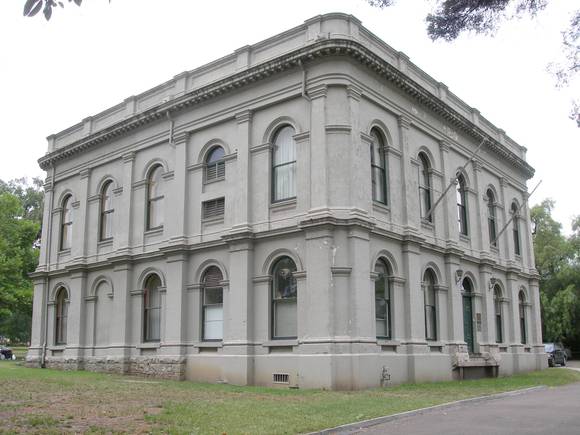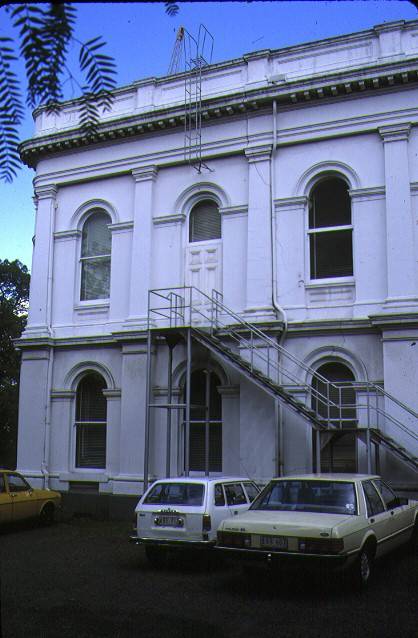| Back to search results » | Back to search page » |
|
ROYAL SOCIETY OF VICTORIA
Location2-8 LA TROBE STREET AND 1-9 VICTORIA STREET MELBOURNE, MELBOURNE CITY
File NumberPLA6037630003LevelRegistered |
|
Statement of Significance
WORLD HERITAGE ENVIRONS AREA OF GREATER SENSITIVITY What is significant? The Royal Society of Victoria, located on a triangular site at the northern edge of the city opposite the Carlton Gardens. The main features are the two-storey Royal Society building, a caretaker's cottage and the Bureau of Meteorology instrument enclosure at the eastern corner of the site. History Summary The Royal Society of Victoria, first known as the Philosophical Institute, was established in 1855 by the amalgamation of the Philosophical Society of Victoria with the Victorian Institute for the Advancement of Science (both formed in 1854). The name was changed to the Royal Society of Victoria in 1859. Its aim was to encourage the growth of scientific knowledge, especially in areas related to the development of Australia's natural resources. A grant of land at the northern edge of the city was given in 1857 to construct a hall for meetings and a caretaker's cottage. Joseph Reed of the firm Reed & Barnes designed the buildings on an honorary basis, and in 1859 the contract for the building of the hall was awarded to Matthew Taylor for a price of £2750. The building then comprised only the three northern bays of the existing building, and the interior was one large open space. In 1869 Reed drew up plans to subdivide the interior to provide a double height meeting room, a council room and a secretary's room on the ground floor and a library and reading room above. The contract for the alterations was awarded to John Wood for £415. Wood also built the adjacent caretaker's cottage, which was completed in 1869 and extended in 1886. In 1880 the hall was again subdivided internally, to provide a supper room on the ground floor and a meeting room above, and the exterior was then rendered. Between 1953 and 1954 a two-storey addition was built along the south side of the building for the use of the Royal College of Obstetricians and Gynaecologists. This added another two bays in the same style as the 1859 building, resulting in a building with a square plan form. Following the transfer of the responsibility for Victoria's meteorological activities to the Commonwealth in 1907, the Bureau of Meteorology (at that time known as the Meteorological Branch/Bureau. Commonwealth of Australia) leased the eastern end of the site from the Society for use as a weather station. Most of Melbourne's weather-recording instruments were installed in 1908 within an enclosure on the eastern corner of the site, and the station has continuously monitored the city's atmospheric and meteorological conditions to the present (January 2014). To mark the centenary of the Royal Society of Victoria in 1959, a small monument, designed by the architects Grounds Romberg and Boyd and incorporating a glacial boulder from Antarctica, was erected on the west side of the site to mark the special interest of the Society in Antarctic exploration and research. Description Summary The Royal Society building is a rendered brick two-storey Renaissance Revival style building with a solid parapet. It is divided into five bays along each side by Tuscan pilasters with arched windows between. The unusual rounded corners of the building are repeated at both the cornice and parapet levels. The 1859 building comprises the three northern bays and the 1953-54 addition comprises the two southern bays of the present structure. The library contains a collection of books and journals dating back to the establishment of the Society. The caretaker's cottage to the east of the hall is a single storey asymmetrically-planned brick building with a hipped slate-clad roof. There are various plantings of shrubs and trees around the perimeter of the main building and in the garden of the cottage. The surroundings are complemented by plantings of Lophostemon confertus (Queensland brush box), Melaleuca styphelioides and three old Schinus molle (Peppercorn). On the eastern corner of the site at the junction of Victoria and La Trobe Streets is the meteorological station, which is a grassed area enclosed by a high cyclone fence. It has on the west side a small wooden shed which dates from the establishment of the station, and located around the site are various recording instruments, all of which have been continually updated and replaced since 1908. This site is part of the traditional land of the Kulin Nation.
How is it significant? The Royal Society of Victoria site is of historical and architectural significance to the State of Victoria. It satisfies the following criteria for inclusion in the Victorian Heritage Register: Criterion A Importance to the course, or pattern, of Victoria's cultural history Criterion D Importance in demonstrating the principal characteristics of a class of cultural places Criterion H Special association with the life or works of a person, or group of persons, of importance in Victoria's history. Why is it significant? The Royal Society of Victoria site is significant at the State level for the following reasons: The Royal Society of Victoria is historically significant as the oldest scientific and philosophical society in Victoria. The Royal Society provided the main forum in Victoria in the nineteenth century for the exchange of intellectual and scientific knowledge, and its members were among the colony's most prominent intellectuals. The Society organised and supported early exploration, including the ill-fated Burke and Wills expedition in 1860, and their bodies lay in state in the hall in 1863. The Royal Society buildings are among the oldest surviving buildings in the City of Melbourne. The Bureau of Meteorology instrument enclosure reflects the scientific interests of the Royal Society. It is historically significant for its role in monitoring the changing atmospheric and meteorological conditions in Melbourne for over a century from 1908. [Criterion A] The Royal Society of Victoria building is an outstanding example of the many public and other halls which were built in the city and suburbs in the nineteenth century as venues for the numerous lectures, recitals, concerts, meeting and theatrical productions which provided entertainment and intellectual stimulation for the population. It is architecturally significant as an outstanding example of the Renaissance Revival style, with the rounded corners on the exterior being particularly unusual. The interiors of the hall and library are notable for their decorative scheme, with Corinthian pilasters which rose the full height of the hall before it was divided horizontally in 1869 and 1880. [Criterion D] The Royal Society of Victoria building is significant for its association with Joseph Reed, one of the most important and prolific of Victoria's nineteenth century architects. Reed dominated the architectural profession in Melbourne at the time and designed many of Melbourne's major buildings in the late 1850s and early 1860s. [Criterion H] The Royal Society of Victoria is also significant for the following reasons, but not at the State level: The Royal Society building is significant as an important meeting place for Melbourne's scientific and intellectual community since the 1850s. The caretaker's cottage is probably the oldest single-storey house in the City of Melbourne still used as a residence. [This Statement of Significance was adopted by the Heritage Council of Victoria at its meeting on 3 April 2014]
Group
Community Facilities
Category
Library
















